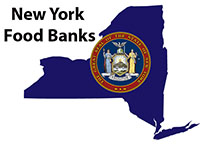Food Insecurity in New York
Food insecurity affects individuals and households across New York, transcending geographical boundaries and demographics. It refers to the limited or uncertain availability of nutritionally adequate and safe food, or the inability to acquire enough food to meet one’s dietary needs.
According to Feeding America’s “Map the Meal Gap” report, in 2021, approximately 11.4% of New York’s population, equivalent to over 2.2 million people, experienced food insecurity.
New York’s Poverty Rate Stood at 13.9%
Various factors contribute to the prevalence of food insecurity in New York. One key factor is the state’s high poverty rate. According to the U.S. Census Bureau, in 2021, New York’s poverty rate stood at 13.9%, surpassing the national average.
Poverty often limits individuals’ purchasing power, forcing them to allocate a significant portion of their income towards other necessities, leaving insufficient funds for adequate and nutritious food.
Additionally, limited access to affordable and nutritious food exacerbates the problem. Many communities in New York, particularly in rural and low-income areas, lack grocery stores or have limited options, resulting in food deserts.
This lack of access to fresh produce and healthy food options makes it challenging for residents to maintain a balanced diet, leading to higher rates of food insecurity.
Consequences of Food Insecurity in New York
Food insecurity has severe consequences for individuals, families, and communities in New York. One of the immediate effects is malnutrition, which can lead to various health issues, including stunted growth, weakened immune systems, and developmental delays, particularly in children.
Food-insecure individuals are also more susceptible to diet-related diseases such as obesity, diabetes, and cardiovascular problems.
Furthermore, food insecurity strains the healthcare system. Individuals experiencing food insecurity are more likely to rely on emergency services and experience higher healthcare costs due to a lack of preventive care and chronic disease management.
The economic impact is significant as well, with decreased productivity and increased healthcare expenses placing a burden on both individuals and the state.
Addressing Food Insecurity in New York
Efforts to combat food insecurity in New York require a multi-faceted and collaborative approach. Here are some potential solutions:
- Strengthening and expanding federal nutrition assistance programs such as the Supplemental Nutrition Assistance Program (SNAP) and the Special Supplemental Nutrition Program for Women, Infants, and Children (WIC), to ensure eligible individuals and families receive adequate support.
- Investing in and promoting community-based initiatives such as food banks, food pantries, and meal programs to provide immediate relief and support for food-insecure individuals and families.
- Increasing access to affordable and nutritious food by incentivizing the establishment of grocery stores, farmers’ markets, and mobile markets in under served areas, through tax incentives or subsidies.
- Expanding school meal programs to ensure that all children have access to nutritious meals during the school day, and investing in summer and after school meal programs to bridge the food gap during non-school months.
- Encouraging partnerships between farmers, food producers, and retailers to increase the availability of locally grown produce and support sustainable agriculture, benefiting both the economy and food access.



